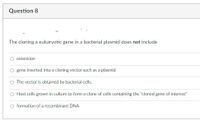
Human Anatomy & Physiology (11th Edition)
11th Edition
ISBN: 9780134580999
Author: Elaine N. Marieb, Katja N. Hoehn
Publisher: PEARSON
expand_more
expand_more
format_list_bulleted
Concept explainers
Question

Transcribed Image Text:Question 8
The cloning a eukaryotic gene in a bacterial plasmid does not include
extension
gene inserted into a cloning vector such as a plasmid
The vector is obtained by bacterial cells.
O Host cells grown in culture to form a clone of cells containing the "cloned gene of interest"
O formation of a recombinant DNA
Expert Solution
This question has been solved!
Explore an expertly crafted, step-by-step solution for a thorough understanding of key concepts.
This is a popular solution
Trending nowThis is a popular solution!
Step by stepSolved in 2 steps

Knowledge Booster
Learn more about
Need a deep-dive on the concept behind this application? Look no further. Learn more about this topic, biology and related others by exploring similar questions and additional content below.Similar questions
- GQ3arrow_forwardhelp to solve question 1 to 4 ( all please)arrow_forward7:14 You have completed an in vitro mutagenesis experiment to create an G to T mutation in the coding sequence of the heat shock protein gene. This gene is cloned in a plasmid and you want to confirm that the mutation was correctly introduced. Which sequencing technology be most appropriate to use practically and economically: O Microarray O Sanger sequencing O RNA sequencing O Exon sequencingarrow_forward
- Question 1 of 10 Question 1. You isolate a mouse Tau-gene-containing DNA fragment from the chicken and hybridize it to the freshly-made and isolated hnRNA (primary transcript) from the nucleus of the mouse cells transcribed from the Tau gene (immediately after it was produced), allowing no time for processing of the hnRNA. Describe what you see when you look at the DNA/RNA hybrid molecule under the electron microscope.arrow_forwardPart A Why are most recombinant human proteins produced in animal or plant hosts instead of bacterial host cells? Bacteria do not process any eukaryotic proteins. Bacterial cells might be harmfull for the researchers. Bacteria might not process all the eukaryotic proteins that might be usefull to process the protein molecule. O Only transgenic eukaryotes are able to process eukaryotic proteins. Submit Request Answerarrow_forwardOnly need help with parts a,b and c please, and thank you!arrow_forward
- Question 6. How does the sequence of the primary transcript resemble the sequence of the gene encoding it?arrow_forward7:07 1 How Mutations Occur (Developing) Question O Practice It! /// A Select the statement(s) that accurately describe the function of DNA polymerase and the types of mutations that may occur. O Point mutations occur when a single nitrogenous base is substituted. Frameshift mutations occur when a nitrogenous base is inserted or deleted. start d le O Point mutations are less serious than frameshift mutations, as only a single base pair is affected. DNA has rare mutations during replication because DNA polymerase functions to build and repair errors in nitrogen base pairings of A-G and T-C. 3 Pro O DNA has rare mutations during replication because DNA polymerase functions to build and repair errors in nitrogen base pairings of A-T and G-C. O Point mutations occur when a nitrogenous base is inserted or deleted. Frameshift mutations occur when a single nitrogenous based is substituted. B.McKenzie - Uncontrolled Cell Growth B.McKenzie - Uncontrolled Cell Growth B.McKenzie - Uncontrolled…arrow_forward7:12 You have completed an in vitro mutagenesis experiment to create an G to T mutation in the coding sequence of the heat shock protein gene. This gene is cloned in a plasmid and you want to confirm that the mutation was correctly introduced. Which sequencing technology be most appropriate to use practically and economically: O Microarray O Sanger sequencing O RNA sequencing O Exon sequencingarrow_forward
arrow_back_ios
arrow_forward_ios
Recommended textbooks for you
 Human Anatomy & Physiology (11th Edition)BiologyISBN:9780134580999Author:Elaine N. Marieb, Katja N. HoehnPublisher:PEARSON
Human Anatomy & Physiology (11th Edition)BiologyISBN:9780134580999Author:Elaine N. Marieb, Katja N. HoehnPublisher:PEARSON Biology 2eBiologyISBN:9781947172517Author:Matthew Douglas, Jung Choi, Mary Ann ClarkPublisher:OpenStax
Biology 2eBiologyISBN:9781947172517Author:Matthew Douglas, Jung Choi, Mary Ann ClarkPublisher:OpenStax Anatomy & PhysiologyBiologyISBN:9781259398629Author:McKinley, Michael P., O'loughlin, Valerie Dean, Bidle, Theresa StouterPublisher:Mcgraw Hill Education,
Anatomy & PhysiologyBiologyISBN:9781259398629Author:McKinley, Michael P., O'loughlin, Valerie Dean, Bidle, Theresa StouterPublisher:Mcgraw Hill Education, Molecular Biology of the Cell (Sixth Edition)BiologyISBN:9780815344322Author:Bruce Alberts, Alexander D. Johnson, Julian Lewis, David Morgan, Martin Raff, Keith Roberts, Peter WalterPublisher:W. W. Norton & Company
Molecular Biology of the Cell (Sixth Edition)BiologyISBN:9780815344322Author:Bruce Alberts, Alexander D. Johnson, Julian Lewis, David Morgan, Martin Raff, Keith Roberts, Peter WalterPublisher:W. W. Norton & Company Laboratory Manual For Human Anatomy & PhysiologyBiologyISBN:9781260159363Author:Martin, Terry R., Prentice-craver, CynthiaPublisher:McGraw-Hill Publishing Co.
Laboratory Manual For Human Anatomy & PhysiologyBiologyISBN:9781260159363Author:Martin, Terry R., Prentice-craver, CynthiaPublisher:McGraw-Hill Publishing Co. Inquiry Into Life (16th Edition)BiologyISBN:9781260231700Author:Sylvia S. Mader, Michael WindelspechtPublisher:McGraw Hill Education
Inquiry Into Life (16th Edition)BiologyISBN:9781260231700Author:Sylvia S. Mader, Michael WindelspechtPublisher:McGraw Hill Education

Human Anatomy & Physiology (11th Edition)
Biology
ISBN:9780134580999
Author:Elaine N. Marieb, Katja N. Hoehn
Publisher:PEARSON

Biology 2e
Biology
ISBN:9781947172517
Author:Matthew Douglas, Jung Choi, Mary Ann Clark
Publisher:OpenStax

Anatomy & Physiology
Biology
ISBN:9781259398629
Author:McKinley, Michael P., O'loughlin, Valerie Dean, Bidle, Theresa Stouter
Publisher:Mcgraw Hill Education,

Molecular Biology of the Cell (Sixth Edition)
Biology
ISBN:9780815344322
Author:Bruce Alberts, Alexander D. Johnson, Julian Lewis, David Morgan, Martin Raff, Keith Roberts, Peter Walter
Publisher:W. W. Norton & Company

Laboratory Manual For Human Anatomy & Physiology
Biology
ISBN:9781260159363
Author:Martin, Terry R., Prentice-craver, Cynthia
Publisher:McGraw-Hill Publishing Co.

Inquiry Into Life (16th Edition)
Biology
ISBN:9781260231700
Author:Sylvia S. Mader, Michael Windelspecht
Publisher:McGraw Hill Education